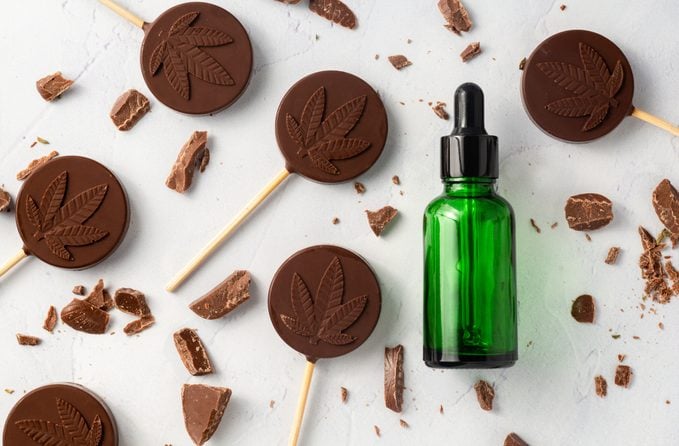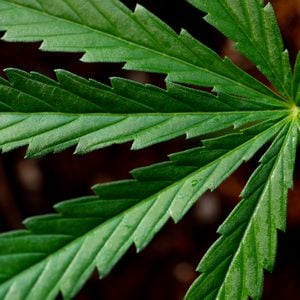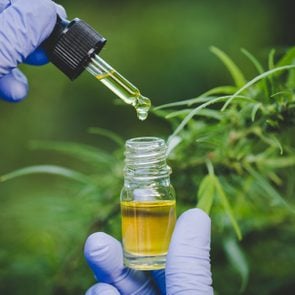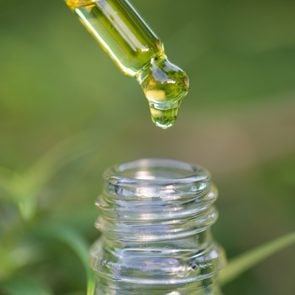Everything You Need to Know About CBD Edibles
Updated: Mar. 05, 2021
From tinctures and oils to gummies, cake pops, and chocolate bars, CBD edibles offer a longer-lasting alternative to inhaled CBD products.
Our editors and experts handpick every product we feature. We may earn a commission from your purchases.
What are CBD edibles?
Name a food or beverage, and there’s a good chance someone is selling a CBD-infused version of it. From coffee, tea, and energy drinks to cookies, candy, and even wine, it’s no surprise that CBD edibles have become ultra-popular. Especially given today’s anxious times and CBD’s reputation for easing the mind and helping with insomnia.
Here’s what experts say about the benefits of CBD edibles, how to optimize their effects, and how to find safe, high-quality products.
What is cannabidiol?
CBD stands for cannabidiol. It comes from the Cannabis sativa plant, which also produces more than 100 other compounds called cannabinoids, as well as beneficial phytochemicals, that protect the plant from pests and damaging ultraviolet rays. Though evidence is scanty, there’s some promise in using CBD for anxiety and CBD for pain.
In addition to CBD oil and CBD tinctures (liquid CBD products sold in small, dropper bottles), popular CBD edibles include gummies and chocolates. CBD comes in capsule form. And you’ll even find fancy treats like cake pops infused with CBD and CBD shots.
Like CBD oil, CBD edibles come in full-spectrum, broad-spectrum, and isolate form. Full-spectrum products contain other cannabinoids, organic compounds called terpenes, and flavonoids from the Cannabis sativa plant, including sometimes delta-9-tetrahydrocannabinol, or THC.
THC is the main mind-altering chemical found in marijuana, but CBD can also be derived from the hemp plant. Hemp plants are also Cannabis sativa (like marijuana), but it’s a variety of the plant with 0.3 percent or lower THC. (Here’s the difference between CBD and THC.) Therefore, if your CBD edible is derived from hemp, it’s likely to have low or only trace amounts of THC.
Broad-spectrum products contain these other ingredients, too—but with the THC removed. CBD isolates contain only CBD. (Here’s more on what CBD isolate is and how to use it.)
Can you eat them?
Of course! That’s what edibles are for. But because the CBD market is essentially unregulated in much of the U.S., it’s up to the consumer to track down products that are safe and actually contain what the label says they do.
Only one in four CBD edibles contains the labeled amount of CBD, according to a November 2020 test of 40 products from 21 brands conducted by CBD online resource Leafreport. Most of the products (63 percent) contained more CBD than advertised.
“Something purchased through a state-licensed dispensary is likely going to have been tested and to come with some consumer protection because of the requirements by the state for quality control,” says Bonni Goldstein, MD, medical director and owner of Cannacenters, a medical practice in Los Angeles, and author of Cannabis is Medicine: How Medical Cannabis and CBD are Healing Everything from Anxiety to Chronic Pain.
“It’s really important that people understand that they have to do a little research—you can’t just pick up any CBD,” she adds. “I’ve heard people liken it to gas station sushi. You just don’t want to go there.”

Are CBD edibles legal?
CBD edibles that are regulated by states with legal medicinal and/or recreational programs are legal under state law, but remain illegal under federal law, which classifies cannabis and its constituents as schedule 1 drugs, with no medical use and a high potential for abuse.
“CBD’s high on the tolerability index for law enforcement it seems, but it is not freely legal no matter what the internet tells you,” says Jahan Marcu, PhD, founding partner of cannabis consultancy Marcu & Arora and editor-in-chief of the American Journal of Endocannabinoid Medicine.
Marcu and other experts agree that if you want to try CBD edibles, you should buy them in states where marijuana is legal and regulated. Outside of this system, there’s no guarantee that products will contain what they say is on the label.
“I would really caution people against using anything that isn’t purchased through a legal operator in their state,” Marcu says. The next best thing is to find a product that has been tested by a reliable lab, he adds. “If they can’t show you a current lab test for a product you should take your business elsewhere and support people who are making products with human beings in mind.”
How to find quality CBD edibles
If you don’t have access to a state-licensed dispensary, “the No. 1 thing to look at is what’s called the Certificate of Analysis,” Dr. Goldstein advises.
Also called the COA, this document shows the results of third-party testing. It indicates the product’s phytocannabinoid profile (how much CBD, THC, terpenes, and other cannabinoids it contains) and whether it’s free from contamination with pesticides, solvents, heavy metals, mold, and bacteria.
The COA should be freely available from the manufacturer. Some CBD products have a QR code you can scan to access the COA. Here again, though, you might have to dig a little deeper, Dr. Goldstein says, because there have been reports of unreliable and even falsified COAs.
“One has to be quite careful,” she adds. “What I recommend is making sure that the name brand has a website, that they have a phone number on the website that you can call to speak with someone.” (Here are the best CBD gummies that meet our experts’ criteria for safety and quality.)
Another sign the company and product are legit, according to Dr. Goldstein, is if they offer a money-back guarantee.
If you’re considering using CBD regularly, Dr. Goldstein says, it might be worthwhile to bring the product you are using to a cannabis testing lab to get it checked out for yourself.
(Here’s what you need to know about drinking CBD water.)
How long do they take to work?
CBD edibles take longer to kick in than smoking or vaping CBD oil, says Martin A. Lee, co-founder and director of Project CBD, a California-based nonprofit, and author of Smoke Signals: A Social History of Marijuana–Medical, Recreational and Scientific.
But their effects are deeper and longer-lived.
It can take anywhere from half an hour to two hours for a CBD edible to take effect. And the effects can last from four to six hours.
You can speed things up a little by keeping a CBD tincture or oil under your tongue, or sublingually, for two minutes. This method allows your bloodstream to absorb CBD directly via the mucous membranes.
What are they used for?
Generally healthy people sometimes try CBD edibles for wellness—for example to help with stress. The U.S. Food and Drug Administration has approved a prescription form of CBD, called Epidiolex, for controlling seizures in children with rare, severe forms of epilepsy due to Dravet syndrome, Lennox-Gestaut syndrome, and tuberous sclerosis complex. (Learn more about using CBD for seizures.)
While many people swear by CBD for sleep, Dr. Goldstein notes that small doses of CBD can actually have energizing effects. Taking enough CBD to experience sedating effects can get very expensive. (Read how one woman successfully uses CBD oil for anxiety and insomnia.)
How much should I take?
“Cannabinoids are not really well absorbed from the gut,” says Sagnik Bhattacharyya, a professor of translational neuroscience and psychiatry at King’s College London, who studies the therapeutic effects of CBD in psychosis. “So when we take a CBD capsule only 6 percent to 15 percent at the most might cross from the gut into the blood for it to be available to produce its effects.”
A gummy with 5 milligrams of CBD is unlikely to have much of an effect, beyond the placebo effect, Dr. Goldstein notes. But that doesn’t mean you should start out with a megadose, she adds. “We tell people to start low dose, titrate up to what feels right for you, and pay attention.”
You can boost your body’s absorption of CBD edibles by taking them with a meal, especially a meal with some fat, and not on an empty stomach, Dr. Goldstein and other experts suggest.
“It has long been known that cannabinoids, CBD or THC, are absorbed quite a bit more efficiently if they are taken before or after a meal,” notes Greg Gerdeman, PhD, a cannabis neuroscientist and educator.
He estimates that eating a piece of buttered toast with your morning dropper of CBD oil could bump absorption up to 30 percent.
Can they make me flunk a drug test?
If you use CBD regularly and are concerned about whether CBD can get you high, your best bet is to stick with broad-spectrum or CBD isolate products that don’t contain THC.
That’s the ingredient in cannabis that causes a high and that drug tests are looking for. Even tiny amounts of THC can build up in the body over time, so it’s crucial to make sure you’re getting a product that really is THC-free.
Again, third-party testing and a reliable COA are key.
The bottom line on CBD edibles
CBD edibles aren’t the most efficient way to consume CBD. But they have long-lasting effects, and many people find them helpful for easing anxiety and stress.
Unless you have access to a state-licensed cannabis dispensary, where products have been tested for potency and purity, you’ll have to do your own research to track down high-quality CBD edibles.



